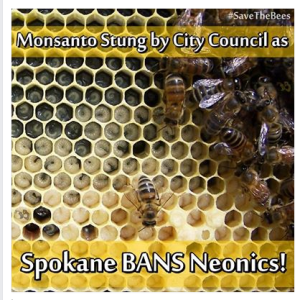 BY DONNA WESTFALL
BY DONNA WESTFALL
CREDIT TO ASHLEY CURTIN, NATIONOFCHANGE/NEWS REPORT
From the Spokane City Council agenda, June 23rd:
“ORD C35106: Relating to a ban on the purchase and use by the City of Spokane of products or products in packaging that contains neonicotinoids; adopting a new Section 7.06.171 to Chapter 7.06 of the Spokane Municipal Code. (Deferred from June 16, 2014, Agenda.)”
What are Neonics?
Neonicotinoids are a new class of insecticides chemically related to nicotine… or neonics for short. They are a class of neuro-active insecticides chemically similar to nicotine. Used for the past 20 years, so relatively new.
We just missed National Pollinator Week running from June 16th through 22nd – a week the U.S. Senate designates to the “protection and promotion of pollinators and their ecosystems.” Pollinating insects and animals are vital to the world. Not only do bees, birds, butterflies, bats, beetles and many other such pollinators support the ecosystem, they provide healthy watershed and maintain terrestrial productivity. Yet pollinators are in a state of decline, especially the bee, which puts human life in danger, threatens global food webs and concerns the integrity of biodiversity.
A possible link between neonicotinoids and honey bee die-offs has led to controversy across the United States and Europe. Beekeepers and environmentalists have expressed growing concern about the impact of neonicotinoids, concern based on the fact that neonicotinoids are absorbed into plant tissue and can be present in pollen and nectar, making them toxic to pollinators.
Many neonicotinoid pesticides that are sold to homeowners for use on lawns and gardens do not have any mention of the risks of these products to bees.
- Neonicotinoid residues are found in pollen and nectar consumed by pollinators such as bees and butterflies. The residues can reach lethal concentrations in some situations.
- Neonicotinoids can persist in soil for months or years after a single application. Measurable amounts of residues were found in woody plants up to six years after application.
- Products approved for homeowners to use in gardens, lawns, and on ornamental trees have manufacturer-recommended application rates up to 120 times higher than rates approved for agricultural crops.
- There is no direct link demonstrated between neonicotinoids and the honey bee syndrome known as Colony Collapse Disorder (CCD). However, recent research suggests that neonicotinoids may make honey bees more susceptible to parasites and pathogens, including the intestinal parasite Nosema, which has been implicated as one causative factor in CCD.
With CCD, the bees are dying off in record numbers. Bees pollinate fruit trees, nut trees, berries, and hundreds of other fruits and vegetables. What happens to our food supply if bees cease to exist?
Have you considered petitioning your City Council to do the same; BAN NEONICS?

